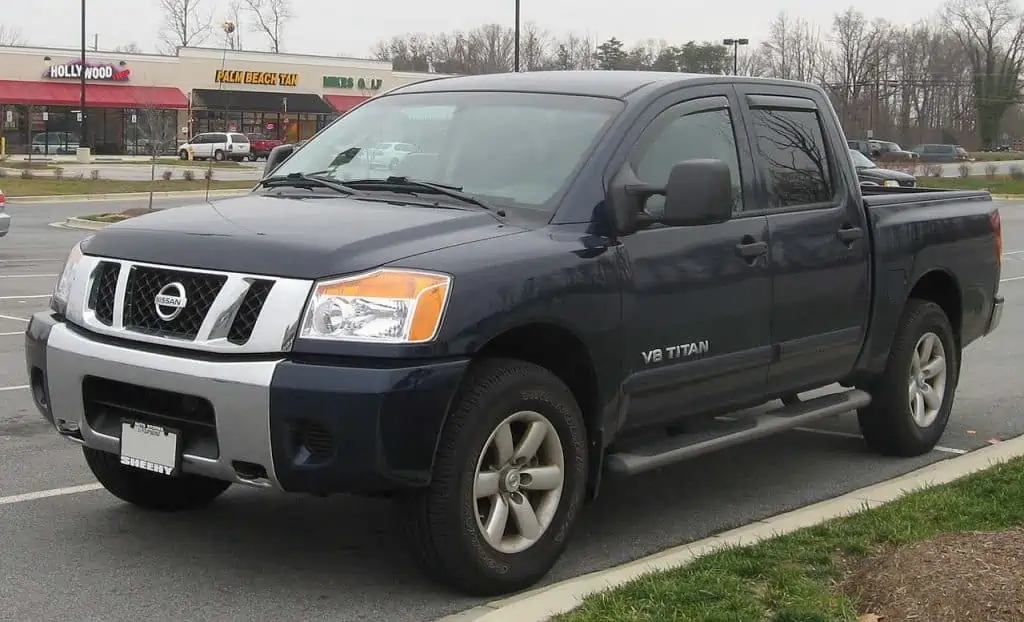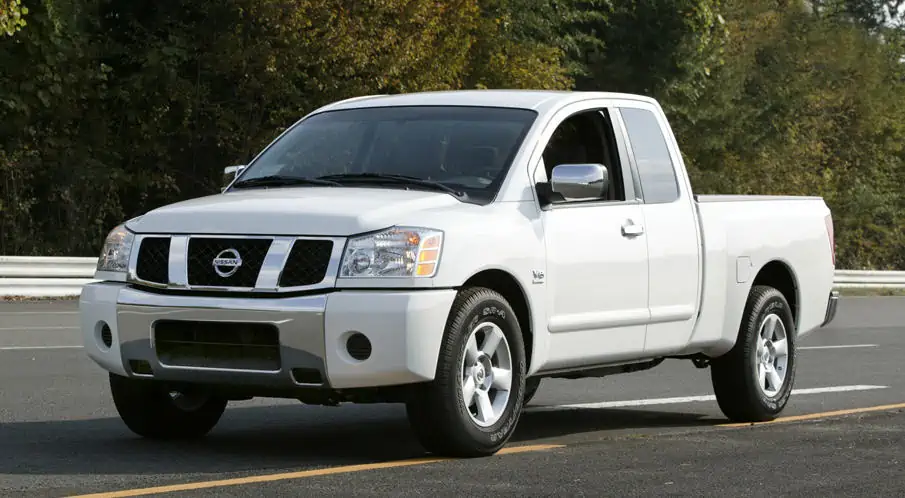Nissan is responsible for the design, engineering, and production of the full-size pickup truck. Nissan is a Japanese automaker that creates a range of automobiles.
The Nissan Titan was manufactured in two generations, the first from 2003 to 2015 and the second from 2016 to the present. This vehicle comes with a 2-door truck or a 4-door truck option.
All across the world, there is still a strong demand for Nissan Titan pickup trucks. Several older models are advised to be avoided as a consequence of customer complaints, the volume of Technical Service Bulletins (TSBs), and numerous recalls.
This vehicle also has problems with previous model years. Some industry critics claim that a few Titan models from previous years might be the source of your dissatisfaction.
Here is what has been learned for your benefit to prevent you from making a poor Nissan Titan purchase. But first, it’s vital to look at the basic issues with Nissan Titans before that.
Nissan Titan’s Most Serious Issues Overall
There were a few major issues that persisted throughout all model years as the Nissan Titan’s most serious issues during its entire existence.
The Drivetrain Issues
One of Titan’s main flaws is its power train, which saw the greatest amount of difficulties in the 2004 model year, which is regarded as the worst in terms of complaints and severity.
Drivers reported a variety of problems, including front and rear differential failure, leaks in the back components, and loud clunking noise.
Defective Brakes
Another problem with the same model year is brake problems that might compromise the safety, including too-soft brake pedals, loud grinding noises, and the need for repeated brake replacements. Additionally, several owners claimed that the front brake rotors on their vehicles had become excessively bent over time.
The Rear Differential Malfunction
Rear differential issues were one of the main issues with the powertrain for the 2004 model year, and they were most frequently experienced with the 5.6-liter V8 engine. Before the back wheels completely locked up while driving, drivers frequently heard an explosive bang or loud clunking sound.
The Rear Axle Malfunction
The rear axle breakdown in the 2005 Titan is the worst issue for all Titan models, costing an average of $3,100 to replace and occurring at a mileage of roughly 78,000 miles. Drivers had to pay for the repairs because Nissan never issued any recalls and provided no prior notice before the axle problems happened.
Transmission Problems
The 2016 Titan experienced several transmission issues. Owners have noted jerking and hard shifting while shifting. According to several stories, their trucks would suddenly halt as they were moving.
The Fuel Pump Malfunction
The fuel system of the truck is another issue with a large number of reports. Owners of Titan trucks have heard whistling or buzzing while filling their tanks. Some users also claimed that a broken catalytic converter was caused by a fuel pump failure.
Erroneous Navigational System
This might seem like a trivial concern since everyone carries a smartphone. Owners of Titan trucks from 2004 and 2005, however, commonly saw “disc error” displays on the built-in navigation system of their vehicles.
A 2017 Nissan Titan XD by Kevauto / CC BY-SA 4.0
Which are the Nissan Titan Years to Avoid? (List of Years)
When Nissan first entered the full-size pickup truck market, things did not go well; in fact, it took some time to get things going.
Although there wasn’t a single catastrophic weakness that all owners experienced in the first few years, there were several problems with the drivetrain, radiator, exhaust system, and brakes.
Below is a list of Nissan Titan years to avoid:
- The 2004 Nissan Titan
- The 2005 Nissan Titan
- The 2006 Nissan Titan
- The 2008 Nissan Titan
- The 2016 Nissan Titan
- The 2018 Nissan Titan
As we’ve already said, there were a few major problems that persisted throughout all model years of the Nissan Titan’s manufacture that were the most severe ones.
Nissan Titan 2004 Issues
Regarding the Nissan Titan, the initial year was also among the worst with some of the most user complaints of all the generations; the model year 2005 is the only one worse. See why will we?
The drivetrain and cooling system are the top customer issues for the 2014 Nissan, and the NHTSA received over 450 complaints specifically about the drivetrain.
Rear differential failure, front differential failure, leaking rear wheel seals, reverse clunking sounds, and deterioration of the cooling system are the drivetrain concerns that consumers experience.
Users claim that the wheels might lock up while being used and create a dangerous scenario. The normal repair cost to correct the rear differential alone is approximately $3,000 and happens at roughly 95,000 miles.
The high-pressure transmission cooler line leak, the radiator splitting and leaking, the transmission fluid seeping into the radiator, the coolant leaking into the gearbox, and the automobile losing coolant with no obvious leaks are the cooling system problems that customers experience.
The radiator leaks frequently, the owners’ report, and the normal repair costs around $400. It happens at about 90,000 miles.
Nissan Titan 2005 Issues
The electrical system is followed by the drivetrain as the primary problem with the 2005 Nissan Titan.
Similar to the previous year, consumers have reported drivetrain issues including rear axle failure, seal leaks, differential failure, and front differential failure and leakage.
These problems typically occur around 78,000 miles and cost $3,100 to repair.
Users said that the 44 did not function, the car shuts down while in motion, the BCM can malfunction, the cruise control button malfunctioned, and the wiring harness had problems. The electrical system was the other area of worry for the 205 Titan.
Users report that the ABS can malfunction when the vehicle is in motion and that the 44 lights often come on at roughly 73,000 miles.
Nissan Titan 2006 Issues
Similar drivetrain troubles plagued the 2006 Titan, although there were much fewer complaints than in prior years, indicating that Nissan was making considerable efforts to lessen differential and powertrain issues.
The engine was the subject of the second group of NHTSA complaints.
The engine, engine cooling, vehicle speed control, and cooling systems were the subject of more than 60 complaints, according to the NHTSA.
Users report that the check engine light comes up, smoke is coming out of the exhaust, and the transition is sluggish when driving. These problems have caused 1 fire and happened at roughly 86,000 miles.
Nissan Titan 2008 Issues
Compared to the previous year, the 2008 Titan experienced a few additional faults, although they were in different areas rather than the drivetrain.
The NHTSA received the most complaints regarding the drivetrain and engine, with the gearbox and suspension being the top user issues.
The user’s transmission problems included a locked gear shifter, coolant pouring into the transmission, the car failing in reverse, and a broken transmission cooler line.
The shifter’s inability to move out of the park requires a repair, which typically has to be done at roughly 101,000 miles.
The suspension’s user problems are caused by the failure of the upper control arm, swing arm bushing, outer tie rod, and ball joints, with a normal repair cost of $450 and an average failure mileage of 130,000 miles.
Nissan Titan 2016 Issues
In 2016, there were a few more significant concerns about the vehicle after four years of extremely few issues reported by customers and the NHTSA throughout manufacturing.
The NHTSA said that the engine was the subject of the majority of consumer complaints, which mostly concerned the exhaust system and the transmission.
The pollutants in the interior and the fluid consumption are the two main issues with the exhaust, with an average mileage of about 5,000 miles.
Owners who have complained about the transmission claim that it shifts quite harshly, jerks while accelerating, and sometimes even stops moving altogether while they are driving. A typical repair is required at just under 10,000 miles.
Nissan Titan 2018 Issues
The fuel system on the 2018 Nissan Titan is one of the most often encountered issues.
Many owners have mentioned hearing whistling sounds coming from the filler neck while the gasoline tank is being replenished.
Others have attributed fuel pump failures to clogged fuel filters.
2004 Nissan Titan King Cab by 天然ガス / CC BY-SA 3.0
Which Nissan Titan Model Years are Safe to Purchase?
Since the second generation was launched, there haven’t been any significant problems save a few small concerns with the 2017 and 2019 versions. A first-generation was created starting in 2003 and continued for ten years. A second generation has been created since 2016.
Even though these models are spanking new, less than half as many issues have been reported with them as with the 2016 or 2018 models.
- The 2007 Nissan Titan
- The 2009 Nissan Titan
- The 2010 Nissan Titan
- The 2011 Nissan Titan
- The 2012 Nissan Titan
- The 2013 Nissan Titan
- The 2014 Nissan Titan
- The 2015 Nissan Titan
- The 2017 Nissan Titan
- The 2019 Nissan Titan
- The 2020 Nissan Titan
The Nissan Titan found stable ground in 2007, with relatively few owner complaints posted to CarComplaints.com, after sputtering during its first three years. On the 2007 Titan, complaints dropped from the initial 2004 model year to just eight.
And the eight complaints weren’t the result of one serious fault; rather, they were unrelated, minor problems that could easily be fixed.
After a few issues for the 2008 model, there were even fewer issues for the 2009 model, with only four complaints across interior accessories, paint, exhaust, and air conditioning.
For the remainder of the first generation of Titans, difficulties were documented throughout the next years extremely infrequently.
For any model year, there haven’t been many problems since the introduction of the second generation. However, the models from 2017, 2019, and 2020 are your best bets.
Despite being new, these models had fewer problems recorded than either the 2016 model or the 2018 model. Time will tell if these Titans hold up well over time, but for the time being, there is no need to ignore these Titans’ model years.
These are the safest Nissan Titan model years to purchase. The greatest options among them are 2011, 2012, 2014, 2015, 2017, and 2021. They are the ones with the fewest downsides, which is the main explanation.
Users gush about how easy these models are to operate and how entertaining they are. They haven’t received as many calls back as a result.
Reliability of the 2020 Nissan Titan
The 2020 Nissan Titan received 7.4 out of 10 ratings and was ranked #5 in the category of full-size pickup trucks.
The Titan received a score of 7.2 from critics, 7.3 out of 10 for performance, 7.2 for the interior, and 3 out of 5 ratings for JD Power Reliability, according to the Car US News Scorecard.
Unfortunately, the Titan’s limited carrying and towing capability plus some lack of flair in the interior of the cab resulted in it being ranked rather low in the full-size pickup truck class.
The Nissan Titan Recalls
The early production variants of the Nissan Titan have several recalls that need to be rectified. In 2004, seat belt anchoring was the focus of one of the initial recalls.
A section on the rear pillar where the rear seat belt upper anchor is located could not be sturdy enough to adequately absorb collision energy.
Another early recall that included speaker and seat belt wires breaking and making contact was the wire harness recall in 2006, which might have led to the pre-tensioner deploying.
The driver won’t be able to utilize the seat belt if this occurs when the seat belt is being retracted. The risk of harm increases significantly if a wire on the harness breaks.
A second recall for the seat belt was announced in 2007, this time concentrating on the rear center seat belt.
The seat back forms on the retractor spool on some crew cab models of vehicles might not be adequate for the rear center seat belt to release from the automated lock.
If this occurs, it could be challenging to remove the seat belt from the retractor and utilize it effectively.
Is a Nissan Titan Reliable?
A pickup truck with a body-on-frame construction is called the Titan. Unsurprisingly, it can travel on any surface and keep up its excellent condition.
The Nissan Titan’s success on several reliability ratings provides more evidence of its dependability.
It receives a 3.5 dependability rating from RepairPal, placing it as the second most dependable full-size truck.
In the same vein, J.D. Power gives the 2020 model an above-average 89 percent quality and dependability grade.
Additionally, the truck received ratings of 79 for the driving experience and 88 for resale value from the rating company.
How Many Miles Can a Nissan Titan Be Expected to Travel?
A Nissan Titan should have at least 250,000 miles on it. For a typical American driver, it equates to more than 16 years. Despite the challenging jobs that many owners subject their Titans to, with good care and maintenance, the car may live for many years.
The majority of used truck purchasers become fixated on a vehicle’s mileage cap, believing it to be the greatest gauge of the truck’s caliber. I’ll be the first to admit that although mileage data might be useful, you also need to take into account the maintenance expenditures necessary to keep your vehicle operating within those parameters.
Every decent pickup truck, whether it is driven by gasoline or diesel, is constructed with excellent fuel efficiency in mind.
Trucks are purposefully designed to have less power than compact automobiles, which typically have one turbo or even twin-turbo setups with small-displacement engines.
Nissan Titan in Las Vegas by Alexander Migl / CC BY-SA 4.0
The tough, low-compression truck engines provide more than enough power to do the work without needing to be pushed. Trucks and SUVs dominate the lists of vehicles with high mileage since they often outlive passenger cars.
How Much Does the Nissan Titan Maintenance Cost?
The dependability statistics reveal how probable it is for a vehicle to experience unplanned breakdowns, while maintenance expenses are used to pay for required maintenance and repairs. This involves changing the brake pads and brake fluid, as well as the oil, filters, tires, AC recharge, and tire alignment.
According to CarEdge’s numbers, which are based on a very strict maintenance plan, the Nissan Titan will cost $8,645 to maintain for its first 10 years of use, which is $1,420 less than the segment’s average.
The cost of maintenance throughout the warranty term is removed, bringing the total down to around $6,000. Depending on how frequently you change your oil and rotate your tires, however, the cost may be considerably lower.
According to YourMechanic’s estimate and CarEdge statistics, the average yearly maintenance cost for a vehicle for 12 years is $652. Similar data may be found on RepairPal, which claims that the Nissan Titan typically costs $555 per year to fix.
Edmunds frequently quotes the most expensive maintenance costs, which I don’t believe to be correct. For example, the first five years of maintenance will cost $6,000, which is an astronomical sum when you consider the numerous procedures that might be performed over that time.
What Is the Warranty for a Nissan Titan?
The Nissan Titan manufacturer’s warranty may be a wonderful indicator of a product’s construction and marketing approach. There are several factors at play, like comparing the purchase price to the warranty or utilizing it as a gauge of reliability. In any event, more mileage and longer duration are always preferable.
A bumper-to-bumper 5-year/100,000-mile limited warranty is included with the new Nissan Titan. Nissan’s policy only covers the engine, fully-boxed, full-length ladder frame, and multi-leaf rear suspension, so you can always locate the limited portion in there.
Nissan is attempting to outperform its rivals by providing a far better warranty package. The new Ford F-150, Chevrolet Silverado 1500, Ram 1500, and Toyota Tundra all have bumper-to-bumper warranties that last for three years or 36,000 miles.
Nissan Titan might be a fantastic choice for someone who travels more than 15,000 miles annually and can fully utilize the warranty.
2016 Nissan Titan XD SL Crew Cab 5.0L rear by Kevauto / CC BY-SA 4.0
Conclusion
The Nissan Titan has a lot of standard safety and entertainment amenities, a good warranty, and the highest payload for the car’s class.
The Nissan Titan’s drawbacks include the vehicle’s single powertrain option, the crew cab’s lack of competition-level space, its inferior towing capability, and its mediocre interior quality and design.
We do, however, hope that this post was informative and provided answers to your queries. You can make an educated choice now that you are aware of the Nissan Titan’s best and worst years.
The top Nissan Titan models mentioned above are my top picks since they are flawless and have never been recalled.
If you’re still unsure, do further study but stay away from the worst years because they have several significant problems that make driving risky.


Nyangano Maurice specializes in vehicle troubleshooting and has more than 10 years of experience in the automobile industry. Over many years of experience as a car mechanic, he has acquired a broad range of skills, including engine repair, brake systems, electrical systems, and more. He frequently hosts community workshops and training programs to help motor vehicle owners understand their vehicles better.






